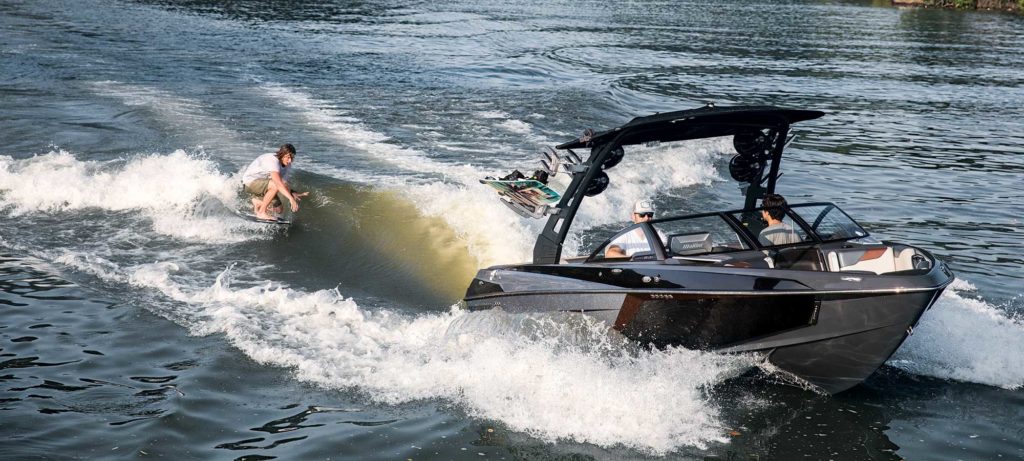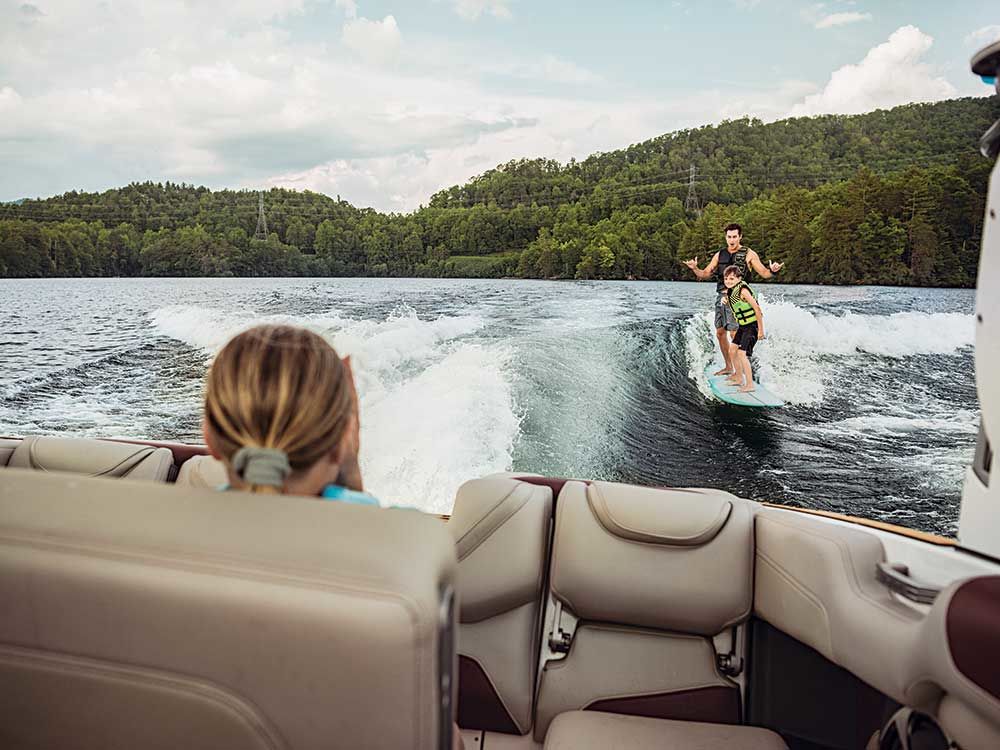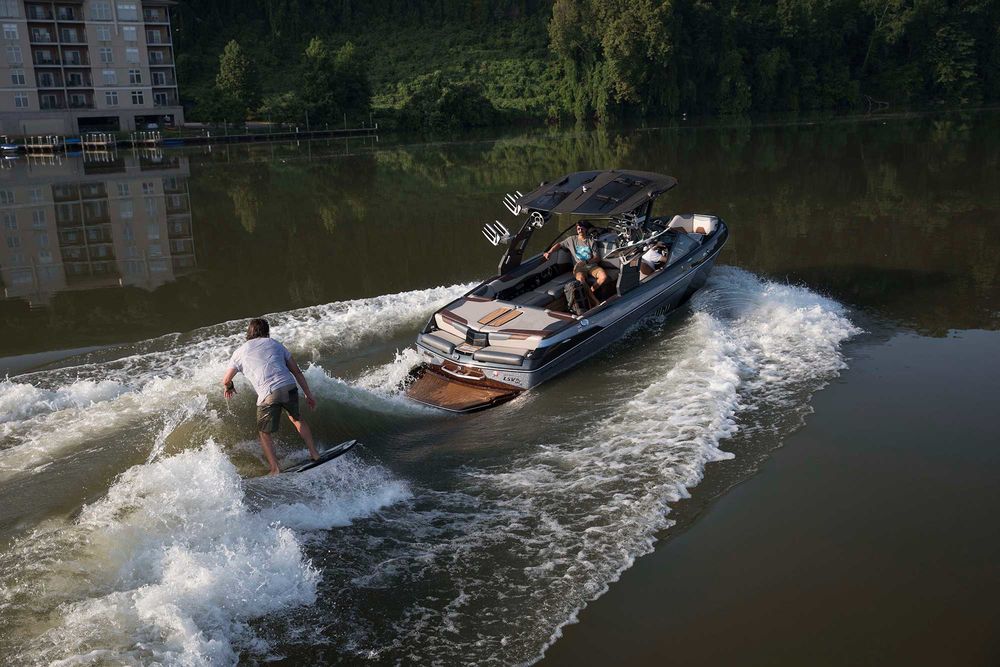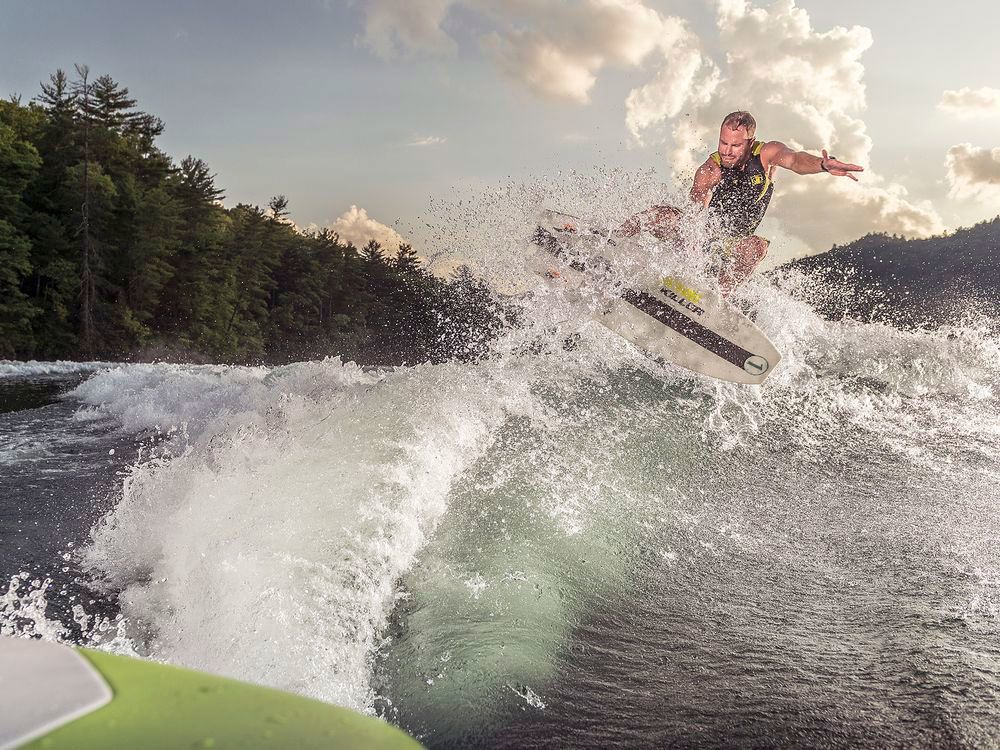
Wakesurfing has all but taken over the watersports scene. Easier falls, a mellower learning curve and a laid-back lifestyle all contribute to the sport’s ever-increasing popularity and the reputation it enjoys as one of the fastest-growing watersports on the planet. Whether you’re 15 or 50, you can wakesurf. We guarantee it. And what’s more than that, you’re not just going to get up, you’re going to have a blast. There’s truly something for everyone when it comes to wakesurfing, and there’s a perfect boat out there for every wakesurf crew. We’re here to help you find it.
As V-drive inboards have gotten bigger and more advanced, wakesurf waves have grown exponentially (while at the same time becoming easier to create). For years, inboards have naturally created ocean-like swells, and they could always be safely surfed due to their inboard-motor configuration that tucked the propeller safely under the boat. Over time, direct-drives evolved to V-drives, and the boat’s center of gravity moved to the back, which buried the stern in the water and made for meatier wakesurfing swells. The bottom surface has also evolved, morphing from nearly flat bottoms for small slalom wakes to the now industry-standard deep-V hull bottom, which plows through the water and displaces an insane amount of water to create a thigh-high wave to play on.

Hull design has also evolved to make deeper boats with a higher freeboard and gunwales that allow for more ballast to create bigger and bigger waves. Boats have intentionally gone from lighter to heavier in an effort to move more lake from underneath your boat to behind your boat in the form of a wall of water. A deeper boat means a heavier, bigger boat, and that means you can safely use more ballast. Ballast bags started out on the floor, then moved to compartments with external pumps, and then got plumbed in with switches at the dash that made weighing down your boat a breeze. Several boats took it to the next level by filling the liner of the boat — the space between the deck and the hull bottom — with water. Subfloor ballast lets you safely put a staggering amount of water weight into the boat without cluttering up your seating area.
With all this wake-making potential, you need something to control the shape of the wave when it’s formed on the hull bottom. The science of wave-making is surprisingly complex; the boat’s weighting needs to be in specific front-to-back and side-to-side ratios or you might end up with a crumbly mess of a wave or a wave that lacks drive and push.

The old way of creating a wave was by heaving all your ballast to one side of the boat and living your life on the water in this crazy tilted world that gave you a big chiropractor bill by the end of the day. Most high-end inboards now have systems with wakeshaping plates that swing out or slide down from either side of the boat’s transom to crab the boat’s running attitude slightly and generate a massive wave without having to stick all your weight on one side. It’s hard to overstate how convenient it is to keep the same weighting configuration on every single set regardless of whether your rider is goofy or regular foot. The cool thing is that some of these systems even allow you to make a wave on either side of the boat almost instantaneously so you can transfer from one side to the other while riding. This transfer feature reveals a whole new realm of tricks. Every surf system is different, so you need to try them to see what style of wave you like the best.
Modern wakesurf boats will also have some sort of plate just behind the rudder that is actuated from the dash and changes the pitch of the boat while underway, typically dragging to make the stern dig in and the bow ride a little higher. This usually makes the wave bigger, steeper and more abrupt in one position, but it can also make the pocket longer and the whole wave more mellow in another position.

Finally, a note about size. If you’ve never owned a boat before, you might not think there’s much difference between a 21-footer and a 25-footer, but we’re here to tell you there’s a world of difference in that four-foot span. You have a lot to consider when buying a wakesurf boat, and size just might be the most important point. The first thing you should look into is whether the waterway you plan to surf on has size restrictions for boats. If it does, you may be in a 21-foot boat no matter what. Your next consideration is storage. If you plan to keep the boat in your garage, you will almost certainly need to have a 21-footer or smaller, unless you’re lucky enough to have a “Garage Mahal” with space for a 25-foot beast. Next up is your tow vehicle. Currently, wakesports-specific inboards weigh in anywhere from 4,500-6,500 pounds, which is no light load for any truck. Consider as well that towing a boat on flat ground is very different than towing up hills, and factor in the possibility of potentially needing four-wheel drive to get out of the launch ramp. With all the hassle that comes with a bigger boat, why would anyone even bother? You’ll know as soon as you go out on a 23- to 25-footer. A longer length means a wider beam (width from side to side) as well as more capacity, which translates into more ballast. More seating also means more weight for your wave. And it may not sound like a big deal, but storage in a big boat is crucial to accommodate a large crew for a day on the water. All this extra weight makes your wakesurf wake enormous. You’ve never wakesurfed until you’ve comfortably ridden 20 feet behind the boat tucked into the curl generated by a huge boat. That’s not to take anything away from the stellar performance you can get from a modern 21-foot wakesurf boat, but the physics just aren’t there to create as big a wave as the monsters can.
Of course, you can read and watch our in-depth reviews on lots of this year’s boats via our Boat Buyer’s Guide page.









